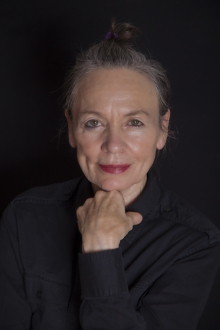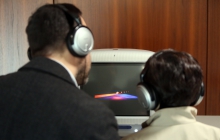Language is a Virus from Outer Space
Language is a Virus from Outer Space
The phrase “language of the future” is compellingly ambiguous. Is it the language we will speak in the future? Is it the language we use to discuss the future? Either or both, Laurie Anderson has long dallied with the phrase, using it to encompass a host of her projects over several decades. For Anderson, one thing is certain: the language of the future is structured by narrative. Muriel Rukeyser could easily be ventriloquizing Anderson in the oft-quoted line: “The universe is made up of stories, not atoms.”
Beginning with large-scale performances that arose from 1970s New York’s experimental performance scene, storytelling has always occupied the center of Anderson’s multimedia artistic production. Language, as a fundamental medium for creating worlds and meaning about those worlds, operates as the primary character in her narratives, whether in music or performance. When telling these early stories, Anderson’s voice was run through a vocoder that allowed her to speak as both male and female, switching as required for the proper narrative voice. An examination of what Homi K. Bhabha calls “the enunciative modality”—the space, conditions and event of speech—has characterized her work ever since.
The Language of the Future appeared in a work from 1984 by Nam June Paik, the “first video artist” and perhaps also the first to use satellites as a medium for the delivery of art. His New Year’s Day riposte to George Orwell’s 1984 was called Good Morning, Mr. Orwell, in an effort to emphasize the positives of teletechnological innovation. Forming an updated version of Allan Kaprow’s “happenings,” the work featured a host of the most inventive artists and performers of the moment such as Joseph Beuys, John Cage, Merce Cunningham, Peter Gabriel, Philip Glass, Allen Ginsberg, and Astor Piazzolla.
Anderson’s contribution starts with the narrator describing the experience of being on a plane in free fall before being miraculously saved by a chance natural occurrence. On a later flight, the same narrator sits next to a teenage girl whose speech is strewn with “computerese,” a “high-tech lingo” befitting the early 1980s. The girl describes her relationship with her boyfriend as “so digital,” which Anderson’s narrator decodes as meaning “on again/off again.” Her language of the future is “always two things switching, one thing instantly replaces the other” and offers an analog/digital binary engagement of storytelling and performance.
The satellite broadcast of Good Morning, Mr. Orwell linked New York City, Paris and San Francisco to celebrate the cultural and liberatory dimensions of electronic telecommunications. In light of their use for post-9/11 intensive surveillance of citizens by the NSA, Orwell’s vision seems to have gotten the better of Paik’s. In an unintended gesture to glitch aesthetics, the broadcast failed at various points to deliver on its technological promises, leaving performers alone with dead air. This confluence of technological reach, ambition and failure mixed with ironic humor often makes its way into Anderson’s performances.
ever elusive, the theme for the thirtieth iteration of transmediale, could also be applied to Anderson, whose consistent body of work nonetheless manifests itself as a protean corpus. Anderson called herself a multimedia artist in the 1970s because “no one knew what that meant.” Multimedia, then, included various artistic practices whereas by the nineties it referred mostly to computer-based art platforms. Fittingly, Anderson presented her CD-ROM art game Puppet Motel at the 1996 edition of the festival. Featuring music, language games, Lynchian hotel spaces, and numerous impossible-to-complete narratives, Puppet Motel performs in software the ever-elusive elements of her current performance works.
For her 2013 collaborative performance piece with the Kronos Quartet entitled Landfall, Anderson developed a software program called ERST, which further explored the artist’s long-standing interest in the relationship between music and language, generating words from the sounds made by the musicians’ instruments. The resulting aural and visual palimpsest of recorded sounds, live music, live spoken word, recorded word, and live computer-generated text projections serve to create fissures in the narrative underpinning the performance. Composed in the same twelve-month period that saw both Hurricane Sandy and the death of her husband Lou Reed, Anderson’s piece takes the glitches inherent in narrative—the inevitable fractures, elisions, and erasure—using them to construct a humorous and haunting aural landscape of technology, failure, memory, loss, and love: introspective storytelling from the high wire.





